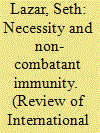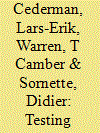|
|
|
Sort Order |
|
|
|
Items / Page
|
|
|
|
|
|
|
| Srl | Item |
| 1 |
ID:
131697


|
|
|
|
|
| Publication |
2014.
|
| Summary/Abstract |
The principle of non-combatant immunity protects non-combatants against intentional attacks in war. It is the most widely endorsed and deeply held moral constraint on the conduct of war. And yet it is difficult to justify. Recent developments in just war theory have undermined the canonical argument in its favour - Michael Walzer's, in Just and Unjust Wars. Some now deny that non-combatant immunity has principled foundations, arguing instead that it is entirely explained by a different principle: that of necessity. In war, as in ordinary life, harms to others can be justified only if they are necessary. Attacking non-combatants, the argument goes, is never necessary, so never justified. Although often repeated, this argument has never been explored in depth. In this article, I evaluate the necessity-based argument for non-combatant immunity, drawing together theoretical analysis and empirical research on anti-civilian tactics in interstate warfare, counterinsurgency, and terrorism.
|
|
|
|
|
|
|
|
|
|
|
|
|
|
|
|
| 2 |
ID:
107530


|
|
|
|
|
| Publication |
2011.
|
| Summary/Abstract |
Drawing on Clausewitz's classical theory, we argue that the emergence of mass nationalism following the French Revolution profoundly altered the nature of the units constituting the interstate system, thereby transforming the conduct of interstate warfare. To validate these assertions-and thus to test Clausewitz-we rely on quantitative evidence at the macro level, with a particular focus on the global distribution of interstate war sizes, measured in terms of battle deaths, over the past five centuries. Drawing on extreme value theory, we demonstrate that temporal discontinuities in the shapes of the tails of such distributions can be used to draw inferences about the nature of the mechanisms underlying the bloodiest events in world history. This approach allows us to show that the interstate system experienced a fundamental shift in the mechanisms underlying the production of war sizes: a shift that can be dated to the years 1770-1810, and that resulted in a systematic increase in war severity. These same tools also allow us to rule out a number of alternative explanations for this shift (including changes in population sizes and changes in weapons technology), while providing evidence for a specific account of war severity rooted in the mobilizational capacities of states.
|
|
|
|
|
|
|
|
|
|
|
|
|
|
|
|
|
|
|
|
|